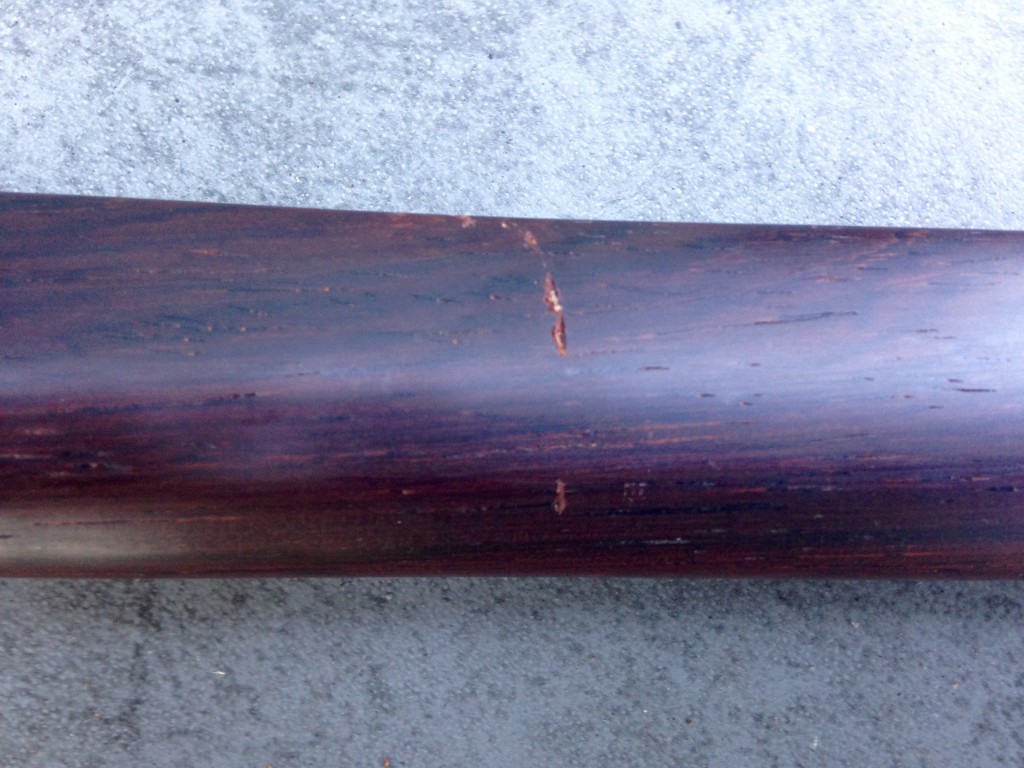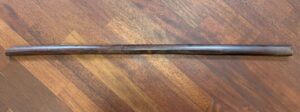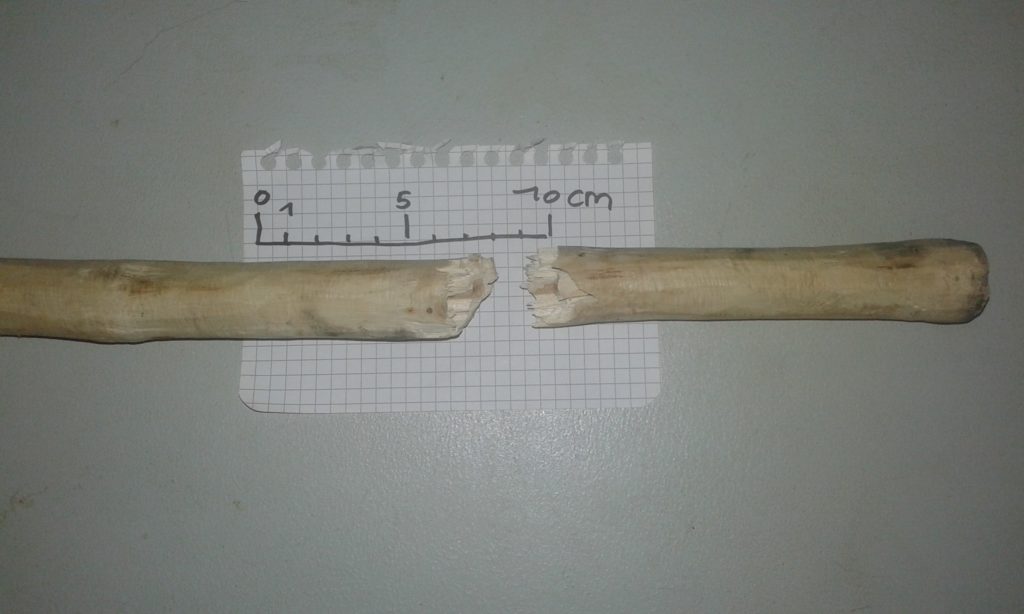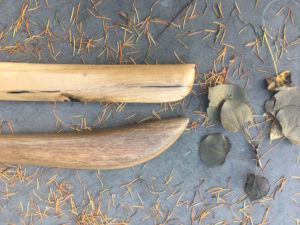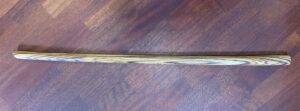There are various reasons that a wood would not be suitable for impact training. Some may be hard, but they are brittle. Others splinter easily. Some are from shrubs or other plants that do not render wood in planks, so their use is limited to a sapling or branch for a club or staff. And others are great woods, but are two twisty to fabricate weaponry suitable for Japanese martial training. (they may be suitable for the fighting arts of other nationalities, such as blackthorn for shillelagh, wax wood for Chinese kun, hackberry for the staff for jogo do pau. Finally, some may be so toxic that they are dangerous to work without a lot of protective equipment. Given that there are other less toxic woods of exemplary qualities, I have relegated some exceptionally toxic woods here.
African Padauk (Pterocarpus marsupium)– a glorious red color, the wood is very heavy and relatively hard. According to a report from koryu practitioner: “I had a Padauk bokken once. It was a beautiful thing to behold but dented easily and broke without taking much abuse.”
- Bending strength – 17,976 psi
- Maximum Crushing strength – 8794 psi
- Shearing strength – 1560 psi
- Static bending – 7840 psi
- Janka Hardness Scale – 1725 – 2219
Birch – Relatively hard wood. My first practice weapon was a two and one-half inch diameter length from a downed black birch sapling. It dents far to easily and is not that strong as far as high impact goes. Shira kaba, Japanese white birch was considered a weed tree in earlier times, and was never used for weapons.
- Bending strength – 16,572 psi
- Maximum Crushing strength – 8173 psi
- Shearing strength – 2027 psi
- Work to Maximum Load – 18 in-lbs./in3
- Janka Hardness Scale is really varied among different species, with a top end of about 1400-1500
Black Palm – It is fairly hard and dense with a very stringy grain. It is lighter than oak or hickory, and is very hard to work. I’ve handled a baton used for Filipino martial arts. It possibly would make an excellent staff weapon, or walking stick, but it is probably too light for Japanese weapons.
- Janka hardness scale – 1400
Bloodwood (Brosimum rubescens) – Beautiful wood! A rich, golden red. Very hard – doesn’t dent very much. Lousy for bending forces. I have a very hefty naginata and I just “cut” through it with a bokuto. Not suitable for weaponry.
- Janka Hardness Scale – 2900
Bubinga (Guibourtia tessmannii) – a beautiful wood, varying from pinkish, reddish and a rich blood/brown. It has a tiger’s eye pattern in the grain. It is rather hard, but brittle as glass. I broke a 1 1/2 inch bo with a pulse of my arms with the weapon across my back. Great for furniture and musical instruments. Not for weapons.
- Janka Hardness Scale – 1980
Camelia (tsubaki Japonica) Camelia wood has become popular as a replacement for biwa, which has become inordinately expensive in Japan. It has similar properties. It is rather flexible, but not that impact resistant.
Cherry – The first weapon I made was of cherrywood. It was absolutely beautiful – a rich orange/red color. It lasted one practice. Deeply dents with impact. Broke with hard impact.
- Janka Hardness Scale – 950
Cocobolo – Almost too beautiful. I’ve got a bokuto of the heartwood that is a dark red with grain that appears almost black in contrast. It feels oily and smooth. It’s very heavy, but not exceptionally hard, the weight due to the natural oils in the wood. It does not take lateral force well. It polishes to a glassy sheen. The dust is dangerous and can produce allergic dermatitis and respiratory problems. I would not use this wood for a weapon that will impact other weapons. I have (carefully) clashed my cocobolo bokuto against a lignum one. You can truly feel the difference – the lignum, although remarkably alive, absorbs the shock. The cocobolo “rings,” transferring the shock right into the hands. I infer from this that it would be, if struck hard, almost feel like hitting metal. Cocobolo promises devastating impact to the body – I understand it has been used for police billy clubs and there has been criticism that it is too damaging – but it is not for dual practice. Janka Hardness Scale – appr 3000 (the numbers for cocobolo are all over the place–I’ve seen as low as 1136–suggesting that several woods with the same name have been tested.)
Cumaru or Tonka (Brazilian Teak – Dipteryx odorata) – A practitioner of stick fighting arts writes: ” Cumaru’s grain patterns are interlocked and wavy. From personal experience it is ultra resistant. The fact its is so dense make it smooth to the touch and has a lively feel to it when swung. It is ideal for thin weapons like some jo or bo. I don’t know if the density can become an issue when made into a bokken though. It has a very beautiful yellowish to dark brown-redish color with a very lively grain; sometimes with white or black stripes.
Per one authority, “Slightly superior to greenheart” in almost all parameters. However, a weapons woodworker wrote to me: “The cumaru is not shaping up so well. The grain is very wavy, with a tendency to raise splinters where the ends of the grain surface. Between the splintering and the difficulty in working due to the grain, and the sheer weight, it’s not suitable for polearms.” I’ve read a second report of a deck maker how notes that splinters continue to lift out of the wood with use. It is my speculation at this point that high impact will lift up the grain in splinters, whereas a low-impact practice would not reveal this deficit. There are far better options among the heavy weapons woods, such as verawood.
- Bending strength – 27,270 psi
- Maximum Crushing strength – 13,720 psi
- Shearing strength – 2419 psi
- Toughness – 265 in-lbs.
- Impact Strength – 39 inches
- Work to Maximum Load – 14 in-lbs./in3
- Janka Hardness Scale – 3450
Ebony (Camoroun or Gabon) – Most ebonies are not suited for weapons. They are certainly heavy and very hard, and the wood, a dense chocolate, almost black, or sometimes, a wild-grain mixture of black and lighter shades, is certainly beautiful. But it is brittle as glass. Coromandel ebony (kamagong) from the Philippines is known in Japan as kokutan. Kokutan bokuto in Japan are vanity items, used as presents. They can make good suburi-to, but are not useful beyond that. Most merely sit on a rack in a tokonoma, never used. One of my informants from SE Asia writes: “It’s known to be exceptionally hard and rot-resistant, but also brittle to impacts against similarly hard objects. Goes right through flesh and bone, but is prone to splintering when contacting another ironwood, or something similarly hard. So it’s only used for real combat or solo practice, not contact practice.” Please note that kamagong is classified as endangered.
- Janka Hardness Scale – within the range of 3220
Ebony (Macassar/ East Indian/) – There are conflicting opinions on this wood, and given it’s price and rarity, that’s enough to rule it out for me. James Goedkoop writes: “Coromandel is strong, hard, has a ideal weight with a fine dense texture. If skillfully shaped and finished, an alive almost reptilian quality emerges with predominantly black with tan figure patterns and occasional subtle but surprising hints of green and other colors. It is arguably one of the most beautiful of all woods.” Two other commentators write that it can have small flaws/fractures inside the wood which can developed with improper curing, resulting in it “exploding” on hard impact. Finally, a hardwood authority writes: “The black heart tends to be brittle, and this species is used for decorative purposes, where strength properties are of minor importance.”
- Janka Hardness Scale – 3250
Greenheart (Chlorocardium rodiei) – Very hard and durable, it was once used to make docks. Some use greenheart as a benchmark wood to compare to others suitable for high-stress/intensity use. It was also used for fly fishing rods, which indicates that it is also very flexible. NOTE: There are several species, quite different, that all are called greenheart. Amundsen and Shackleton’s polar expedition ships were sheathed in greenheart. Problems: it is classified as a “vulnerable” species, the dust is poisonous, causing both respiratory and dermatitus, and the splinters will go septic in your body. James Goedkoop writes that Greenheart, although very resistant to denting, has low shock resistant, and may shatter at higher forces. I visited a lumberyard in Amsterdam which used to market greenheart planks, but despite blowers, hoods and protective suits available, the men in the shop now refuse to cut or work greenheart due to how dangerous this wood can be. If professional lumbermen will not work this wood, it should not be considered as a wood for practice weapon fabrication. There are too many other woods with equal or superior qualities. I will note, however, that a top-level koryu practitioner reports: I have had incredible success with greenheart as a heavy impact weapon over the years (while noting that this is due to particular teachings within his ryu that assist in modulating impact and releasing stresses within the wood).
- Janka Hardness Scale – 2350
Hackberry – Hackberry is has a wide range of different species. One variety, the Mediterranean Hackberry (celitis australis) is also known as the European Nettle tree or Lotus. Other varieties of hackberry vary in hardness (one variety of African celitis is used for flooring). Qualities of the wood are roughly similar to ash, although it is not as hard. It was a wood traditionally used in jogo do pau. A senior modern instructor writes: “The lotus is a bit more flexible on impact than quince (which was the preferred wood for jogo do pau). Its durability depends on the quality of the wood (was it harvested at the right season or is the wood not ripe? Was it a brunch or part of the trunk? Do trainees maintain the staff properly or not by oiling it or placing it in water for 2 hours before use).” Hackberry is remarkable for its ease in streaming and bending. Saplings were used as walking sticks. It is not a wood that would lend itself to being shaped into Japanese training weapons. Obviously it had utility in jogo do pau, but as a kind of weed tree, it is likely that trainees traditionally had any number of saplings to debark and use. The staffs could be smashed together and when they broke, another picked right up to use. It is intriguing that it was soaked in water before practicing.
- Maximum Crushing strength – 5440 psi
- Janka hardness – 880
Honduran Rosewood – a rare, dark reddish tan wood, James Goedkoop asserts that “excellent density, strength, dent resistance and overall physical properties.” One authority, however, writes, “Denser and tougher than Brazilian Rosewood, but is mainly used where strength properties are not important.” A report I’ve received from another practitioner: “Beautiful and broke in a flash. I’ve had several tanto made from that bokken.”
- Janka hardness 2200
Ilex (Holly) – Holly is a rather tough, heavy, close-grained wood, but given that most hollies are more shrubs than trees, it is hard to come by any wood unless you harvest it yourself. It easily checks and warps unless properly seasoned and is not a durable wood when exposed to the elements. A variety was used in Juego de Palo, Canary Island Stick-fighting, as well as for some shillelagh in Ireland. None of the ilex/holly that I have been able to research are very hard, so it is difficult to believe that this wood would be that strong, but it is possible that it is tough like waxwood. Also, it is possible that some species of ilex are just much tougher. Note the photograph below of a French Ilex Pen-bazh (a Breton version of the shillelagh. The was hit against a pine-wood pell – the fibers are short (hence the straight break). Evidently, it looks similar to waxwood, but it’s qualities are different.
- Janka hardness 1020
Mountain Mahogany (Cercocarpus ledifolius) – This little-known tree grows in the Pacific Northwest of North American. The shrub-like tree is slow growing, and it naturally contorts in twists and curves. Native American’s used the wood for bows, digging sticks and spear-heads. It is one of the very few woods that sinks in water (so of course, like half the hardwoods in the world, it, too, is called ironwood). Because it is so twisty, it is unlikely that one will be able to locate a suitable length for practice weapons. I’ve read several reports that it is brittle.
- Janka Hardness Scale – 3200
Oak (American) – Most varieties of American oak are just not up to high standards – they are roughly equivalent to ash. Not as flexible, perhaps, but a little more dent resistant. Because American oak is seasonal, the grain is wild and open. I would not choose this wood for a weapon, unless there was nothing else available. A general principle should be that only evergreen rather than deciduous oaks are suitable for impact weapons.
- American white oak has a Janka Hardness Scale of 1360.
- American red oak is 1290.
Oak (Sessile AKA English Brown Oak – Quercus petraea) – Its qualities are similar to American Oak rather than kashi. The grain is rather wild. I received a thick straight bokken, very well crafted. I tested it against a Japanese kashi bokken. At 20% strength impact, the Sessile Oak bokken dented rather deeply, while there were no dents in the kashi bokken. We increased the impact to about 30-40% and there was a marked difference in the feel of the weapons. Kashi absorbs shock, whereas the Sessile Oak “rings” unpleasantly in the hands. At the fourth impact, it broke at an angle along the grain line, as if was cut. I do not recommend this wood for weapons.
- Janka Hardness Scale 1120
Persimmon (Diospyros virginians) – related to ebony, it was once used for golf club heads. Although very hard, it reportedly cracks and warps easily, and thus must be cured with considerable care. It has been used to make drumsticks and traditional wood bows. The heartwood is dark brown, where the sapwood is pale in color. Persimmon trees are almost entirely sapwood (the heartwood is dark and may only be an inch in diameter). They are also very susceptible to being worm-eaten. Uncommon for lumber anyway, it’s very hard to get a plank that is not worm-eaten. Of persimmon, one authority writes: “The bending strength qualities of this species in the air-dry condition is very high, far superior to those of Mahogany. Compression strength parallel to the grain, or maximum crushing strength is very high – higher than in Teak or Hard maple. . . . It does not mar or dent easily, and the wood is very dense. Japanese persimmon (kaki) of which there are few rating numbers, was rarely used for wooden weapons or tool handles, although it was used to make traditional musical instruments. Perhaps this is either due to the value of the trees, or that, cultivated as fruit trees, few grew straight and broad.
Persimmon proved to be a disappointment. As you can see by the numbers, it looks great. As you can see by the photos, it’s beautiful. It makes a wonderful, heavy suburi-to, as you can see in the picture. But the bokuto and naginata are just not suitable. They feel great – for me, almost a perfect weight for practice weaponry, heavier than evergreen oak or hickory, but not inordinately so. However, they ‘ring’ unpleasantly in the hands upon impact, something I’ve found with other ebony species. But more disappointingly, with hard impact between a hickory or kashi bokuto, the persimmon wood was easily crushed into dents, whereas the ‘opponent wood’ was not affected at all. Perhaps it was this plank, this tree. But for the expense of getting an all-too-rare plank, unless you are doing so for the undeniable beauty of the wood, it is not suitable.
- Bending strength – 18,228 psi
- Maximum Crushing strength – 9330 psi
- Shearing strength – 2117 psi
- Work to Maximum Load – 15 in-lbs./in3
- Janka Hardness Scale – 2254
Ramin (Gonystylus bancanus) – A wood from Malaysia and Indonesia. I found the following comment on this site by Kjartan Clausen – “About long fibres, I once made a bokuto out of a wood called Ramin. It had very long, strong straight fibres and seemed to have good crush resistance. The first time the student used it the damn thing split right down the long axis. I swear that wood has absolutely no cross connections at all. Don’t use ramin.”
- Janka Hardness Scale 1300
Rock maple (Acer saccharum) – (A lumber term for wood from a Sugar Maple) – “Rock?” They lie – the only rock one can compare it to is slate. The wood is boring to look at – an off-white without any depth, and it is just not strong enough. I have some spears (well – I only have one right now – having broken the other with a not very hard blow with a bokuto), and with the exception of its greater flexible strength, I would compare it to beech.
- Janka Hardness Scale – 1450
Sabina – this variety of juniper was used in construction, as well as for weaponry (staves) for Canary Island stick fighting. Technically a “softwood,” it is about one-half as strong as oak, and deforms easily under stress. From all I can find, it was a ‘default’ wood, given that quince was the hardest wood they had to use. Janka Hardness Scale ????
Sunuke and Isu – Sunuke is the heartwood of the Isu tree (Distylium racemosum). Distylium, many varieties of which are present in China, are called “winter hazel.” It comes from a tree that grows in Kyushu. It is certainly a good-looking wood – I’ve seen bokuto ranging from an orange/tan to much darker. During my time in Japan, it was regarded as a luxury weapon, although not as much as kokutan. Seido, a maker of traditional Japanese weapons, states that although both sunuke and isu are harder and heavier than Japanese oak, they are not suited for contact practice. Generally speaking, it was not highly regarded for impact resistance among Japanese budoka. It is now quite rare. Janka Hardness Scale ????
Tamarisk – a moderately dense hardwood, used by Juego de Palo practitioners of the Canary Islands. Like sabina, I believe it was a “default” wood, given that quince was the hardest wood they had to use. Janka Hardness Scale ????
Tasmanian Oak – Tassie Oak or Tasmanian Oak is the trade name for a mixture of two or more species from a group of about 8 species with similar appearance and features. The main species included are Mountain Ash, Alpine Ash and Messmate. It is neither an oak nor a true hardwood species. It has a relatively soft Janka rating of 5.5 (metric). This is a very common at most hardware stores and timber merchants in Australia. It dents easily when struck and the dents splinter at the edges making it less than ideal for weapons use. (Report byTim Bathurst)
Teak – Teak is a wonderful wood, almost legendary for its use in shipbuilding, house building (old growth teak, permeated with silica, is almost waterproof). It is not a weapon wood, however.
- Bending strength – 13,710 psi
- Maximum Crushing strength – 7065 psi
- Shearing strength – 1890 psi
- Work to Maximum Load – 12 in-lbs./in3
- Janka Hardness Scale – 1000
Wenge (Millettia laurentii) – beautiful dark brown, sometimes with a wild grain. The dust is toxic, causing an allergic dermititis and respiratory problems. Splinters will go septic. And when it breaks, it breaks savage! Long sharp shards. There is absolutely nothing to recommend this wood as a weapons wood.
- Janka Hardness Scale – 1630
Zebrawood (Microberlinia brazzavillensis) – a lovely rare striped wood. Has a pronounced density gradient between the light and dark stripes. Not suitable for weapons, and too rare to waste on the attempt. It does have a very good feel in the hands, light and lively.
- Janka Hardness Scale – 1525 – 1700
